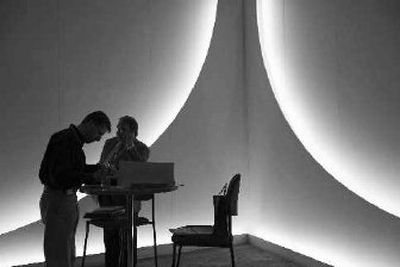The next bright idea

NEW YORK — The light bulb, the symbol of bright ideas, doesn’t look like such a great idea anymore, as lawmakers in the U.S. and abroad are talking about banning the century-old technology because of its contribution to global warming.
But what comes next? Compact fluorescent bulbs are the only real alternative right now, but “bulbs” that use light-emitting diodes, or LEDs, are quickly emerging as a challenger.
LEDs, which are small chips usually encased in a glass dome the size of a matchstick head, have been in use in electronics for decades to indicate, for example, whether a VCR is on or off.
Those LEDs were usually red or green, but a scientific breakthrough in the 1990s paved the way for the production of LEDs that produce white light. Because they use less power than standard incandescent bulbs, white LEDs have become common in flashlights.
Established players in the lighting industry and a host of startups are now grooming LEDs to take on the reigning champion of residential lighting, the familiar pear-shaped incandescent light bulb.
The light bulb has been running out of friends recently. California and Canada have decided to ban the sale of incandescent bulbs by 2012. Australia is banning them in 2010. The European Union is looking at banning production of the bulbs. A U.S. Senate committee is working on a proposal that would phase out the light bulb in 10 years.
And in New Jersey, where the first practical incandescent bulb emerged from Thomas Edison’s laboratory in 1879, a bill has been introduced to ban their use in government buildings.
Governments are gunning for the light bulb because it’s much less efficient than fluorescents, using about five times more energy to produce the same amount of light.
Lighting consumes 22 percent of electricity produced in the U.S., according to the Department of Energy, and widespread use of LED lighting could cut consumption in half. By 2027, LED lighting could cut annual energy use by the equivalent of 500 million barrels of oil, with the attendant reduction in emissions of carbon dioxide, the gas believed to be responsible for global warming.
Much of that reduction would be possible with today’s technology, using compact fluorescents, or CFLs. But consumers haven’t warmed to them. The light quality hasn’t been satisfactory, most take time to turn on and aren’t dimmable.
The LED has advantages over the CFL in most of those areas, and judging by this week’s Lightfair trade show in New York, it could be a serious challenge to the CFL in a few years. What holds it back is chiefly price, but LEDs are already an economic alternative for niche uses.
In the last two years, the diodes have doubled in energy efficiency and brightness, according to Greg Merritt, director of marketing for Durham, N.C.-based LED-manufacturer Cree Inc. In particular, LEDs that produce a yellowish or “warm” light similar to incandescents have improved.
Dallas-based Lighting Science Group Corp. showed an LED “bulb” that screws into a standard medium-sized socket and produces a warm light equivalent to that of a 25-watt incandescent bulb, but consumes just 5.8 watts.
It costs $50, hardly palatable to consumers who can buy a standard bulb for less than a dollar.
Polybrite International, a startup in Naperville, Ill., announced that lighting giant Osram Sylvania, a subsidiary of Germany’s Siemens AG, will distribute its LED “bulbs.” The intended market is mainly commercial clients, who can afford to pay $15 to $85 per unit, according to Osram Sylvania marketing manager Constance Pineault.
The energy efficiency is no doubt a draw for commercial clients like hotels, but LEDs have another big advantage: they last up to 50,000 hours, according to manufacturers. That compares to about 10,000 hours for fluorescents and 1,000 hours for incandescents. Not having to send out janitors to replace burned-out bulbs means big savings in maintenance costs.